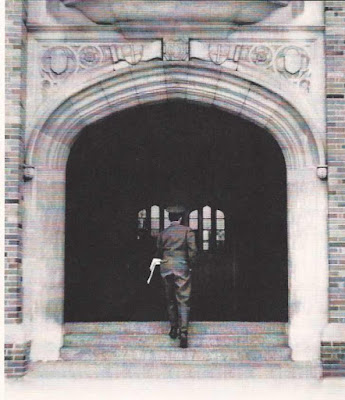Writing
my latest novel ‘Playground for the Devil’ began, like all the rest, as an
exercise in blindly following my instincts and believing that it would all work
out in the end. When I started the project last summer, it was a decision
forced upon me by the COVID-19 pandemic which had closed down ‘live’ theater,
made my planned group reads impossible and creative music sessions not
realistic. My only option seemed to be writing another novel to add to my
portfolio of vernacular ramblings.
I’ve
blogged about this process of creating my twelfth novel twice before in El Pais Grande Del Sur and Fractured Love Affair.
With all due respect to childbearing, for me writing anything is like giving birth. Each manuscript was conceived out of the germ of an idea, thought, or image swirling around my head. They then began to take shape and form as I delved deeply into the storyline and the characters that began to inhabit that space.
My
first gestation of story-telling took place in Reisterstown, Maryland in 1973
and then again in 1974. Impressed by the writings of several well-respected
western writers like Will Henry, I took the first tentative steps toward
creating my own storyline. The result was ‘Apache Death Wind, a trilogy’ and
‘Apache Blue Eyes.’
After
those respective births in print form, it was off to the races. Next came a
semi-autobiographical novel entitled ‘Love in the A Shau’. Then an Ode to Palm
Springs in the form of a trilogy entitled: ‘Debris.’ That streak of novel
writing ended with my 566-page doorstop entitled ‘Follow the Cobbler.’
‘Cobbler’ featured a female protagonist called Katherine (spelt with a K) who
came the closest to resembling my wife. The character is modest, reserved, very
smart and intuitive. The kind of woman who can cut any man off at his southern
fork.
Last
summer, while deep into creating the ‘Playground for the Devil’ storyline, I tried
to share the background for my novel and the interesting characters who lived
in that fictional world in a blog. It really wasn’t until I had finished my
first draft last fall that I felt I knew them all pretty well. And what a
collection of characters I had created! All of them were (cliché here) not what
they seemed to be. What I didn’t know was the extent to which some of them were
damaged and almost bi-polar. They ended up saying and acting in ways my fingers
didn’t understand as I frantically typed in an attempt to keep up with them and
their antics.
My
two protagonists, Brad and Laci, changed, evolved, and slowly began to reveal
more and more about themselves as their story progressed. The emotional
bantering back and forth surprised even me but I just let them’ go at it’ as I
took copious notes in the form of story chapters. I realize now I was retelling
the story of my own relationship with my better half.
Granted
the comparison was done on a very subconscious level but it was there
nevertheless. The Bradley-Laci story is, in retrospect, a metaphor for my own
marriage. As in the book, first impressions don’t count and it’s only after a
period of time and circumstances that the true characteristics of my protagonists
reveal themselves. What seems to be a power imbalance at first slowly morphs
into a realistic balancing act between two strong-willed, determined personalities.
My
first pass at the book jacket showed a two story cabin. However, as the storyline
progressed and my protagonists finally reached their quest, the cabin in
question didn’t fit the image I had created in my mind.
At
that point, a one story cabin was more in line with the structure that emerged
in the novel. The first book cover showed a Big Sur landscape that was simply
too bright and colorful. I needed something dark and sinister that better
conveyed the dangerous environment my protagonists entered into when they
ventured into the backwoods of Big Sur. Vida, my editor and creative designer
came up with three versions of the cover.
Finally,
my editor and I settled on a darker, more sinister landscape that seemed to
better reflect the danger and mystery the Big Sur area presented to my main
characters.
When
I began writing ‘Playground’ I worried that there might not be enough ‘red
herrings’ and twists and turns to my plotline. I needn’t worry because as the
chapters slowly came rolling out of my head, the characters and their quest
took on a number of surprising twists, turns, detours and stumbles. I even
surprised myself by the conclusion to the story.
I
asked myself at the end of my ‘FracturedLove Affair’ blog whether Brad and Laci would be together at the end of the
novel. I never really knew for certain until I typed in ‘The End’ one day. Theirs
was a fractured, wounded relationship that ended the way it was meant to end
for the personalities involved. I think the three of us knew it probably would
end the way it did. No one is complaining.
At
one point, I was torn between labeling my novel a murder mystery or a suspense
thriller. Unsatisfied with either description, I’ll simply call it a suspense
novel with, I hope, enough action and mayhem to satisfy either audience.
A
little over a year ago, I drove up to that big San Francisco mansion for what
turned out to be a swingers party. It only got more complicated, intriguing and
dangerous from there on. It’s been one heck of a venture exploring the
backwoods of Big Sur with these characters who carry more than their own weight
in issues, attitudes, and attributes.
We’ve completed the journey. At least some of us have. There is a deeply satisfying feeling being able to pull it off and hopefully leaving my readers asking for more.















































